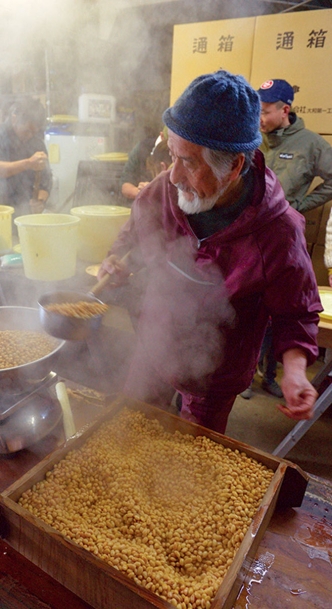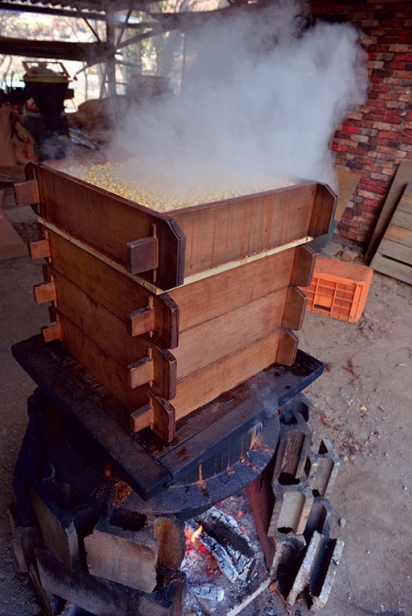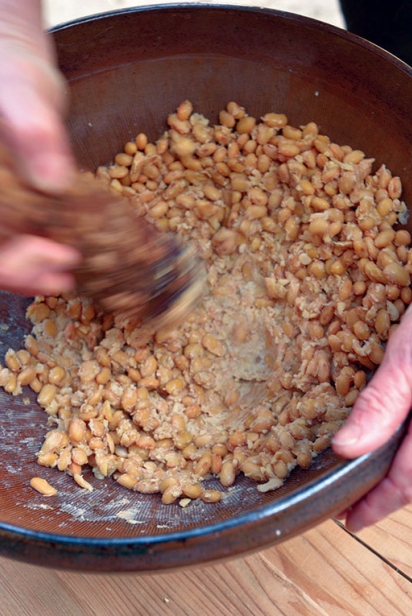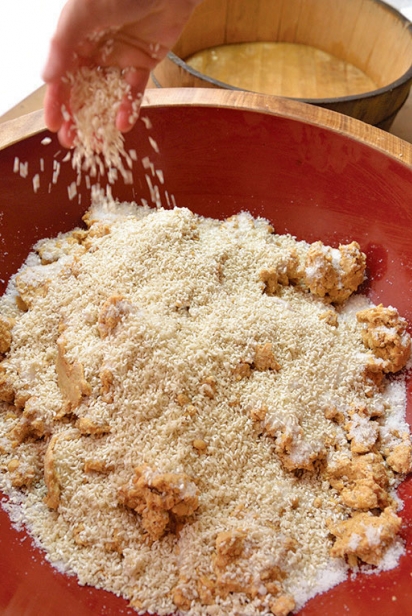Making Miso at Home
I first arrived in Japan in the summer of 1988. I had eaten miso soup, but otherwise really had no idea of how to use miso or what exactly miso was. Each trip to the supermarket was like a bewildering excursion through unknown territory. What were all those strange packaged foods? In the United States we have whole walls of shelves dedicated to breakfast cereal or soft drinks. In 1988 Japan, rice held a prominent wall, as did miso. I remember shelves of plastic containers and bags of miso. I was convinced that those containers held peanut butter, not miso. That shows you how insular I was despite my so-called worldly outlook. Over the years, ironically I lost the taste for peanut butter but developed one for miso with a vengeance–the strange has become commonplace and vice versa.
Miso has been so intertwined with our culinary life that I never gave it much thought. In the early years, my mother-in-law was still making her own miso, so we always had some of her homemade miso in the fridge. But our stock miso was Yamaki Jozo’s inaka miso (literally “country miso”). Inaka miso is made from white rice koji, so it is light in color but has the full flavor of a two-year fermentation that Kyoto-style white miso does not.
In our house, miso was just miso; we never talked varieties and never used the term “red” miso. In fact, it was not until I started thinking about and writing about Japanese farm food that I began to delve beneath the surface of the hows and whys of traditional Japanese foods. I used to take things at face value: Knowing something was well made was enough; I didn’t need to obsess about exactly how it was made. That point of view has changed, though. Many Japanese have lost touch with how traditional foods are made. Consequently, my current mission is to visit the producers of artisanal Japanese foods and share their stories with the Japanese public through my periodic Fuji TV segments.
I also realized that it was simply not enough to gather information. I had to participate in the making of as many of these traditional foods as possible–for the sake of passing on the preservation practices to my sons and future daughters-in-law, and to develop a deeper understanding of the processes. Making miso as a community effort gave me self-confidence and a feeling of personal power. “You can do it!” is a litany I often say to my preschool kids (and to myself). And it is what I want to say to all of you reading this: You can do it! You can make miso.
Pre-WWII most agrarian families made their own miso from the rice and soybeans they grew. The koji was obtained from the local koji maker and the salt from the vendor who sold staples that were not produced at home, such as konbu, katsuobushi, vinegar, and salt. The Kansai area (Kyoto/Osaka) prides itself on a lighter, more delicate cuisine; mountainous and northern areas such as Gifu and Tohoku favor dark misos and deeply flavored foods; whereas Greater Kanto (Tokyo) tends toward a midrange salty palate. In Kyushu, the southern island of Japan, the cuisine is characterized by very fresh fish and, inexplicably, sweetened soy sauce (not to my taste). Seaside areas use less miso than mountainous areas; instead, several abundant varieties of fish are fermented to make fish sauce (shottsuru, ishiri, ishiru) as the condiment of choice (besides soy sauce).
Misos are named for the area they come from (i.e., Saikyo or Hatcho) or the grain used to incubate the koji (brown rice, barley, or soybean). All miso is made from soybeans, koji-inoculated grain, salt, and bit of seed miso (the previous year’s miso diluted in hot water). Inaka miso (country miso) is made from white rice koji and is perhaps named as such because it is the most-used miso in farm cooking. Town people and restaurants tend to use white miso. We have never bought white miso because our local miso company makes 2-year fermented organic misos, and white miso only requires a 30-day to maximum 3-month ferment.
As for selecting miso outside of Japan, there is good news and bad. The good news is that miso is widely available at all supermarkets, not just organic shops or Japanese markets. The bad news is that most of the miso I have come across is oxidized, or in any case darker than its Japanese equivalent. For instance, inaka miso is as dark as the brown rice miso sold in Japan, and the brown rice miso can be as dark as the dark chocolate brown soybean miso (mame miso). For this reason (and because it is so doable), I encourage you to make your own!
Excerpted from Preserving the Japanese Way: Traditions of Salting, Fermenting, and Pickling for the Modern Kitchen, by Nancy Singleton Hachisu/Andrews McMeel Publishing, LLC. Photos courtesy of Nancy Singleton Hachisu.












